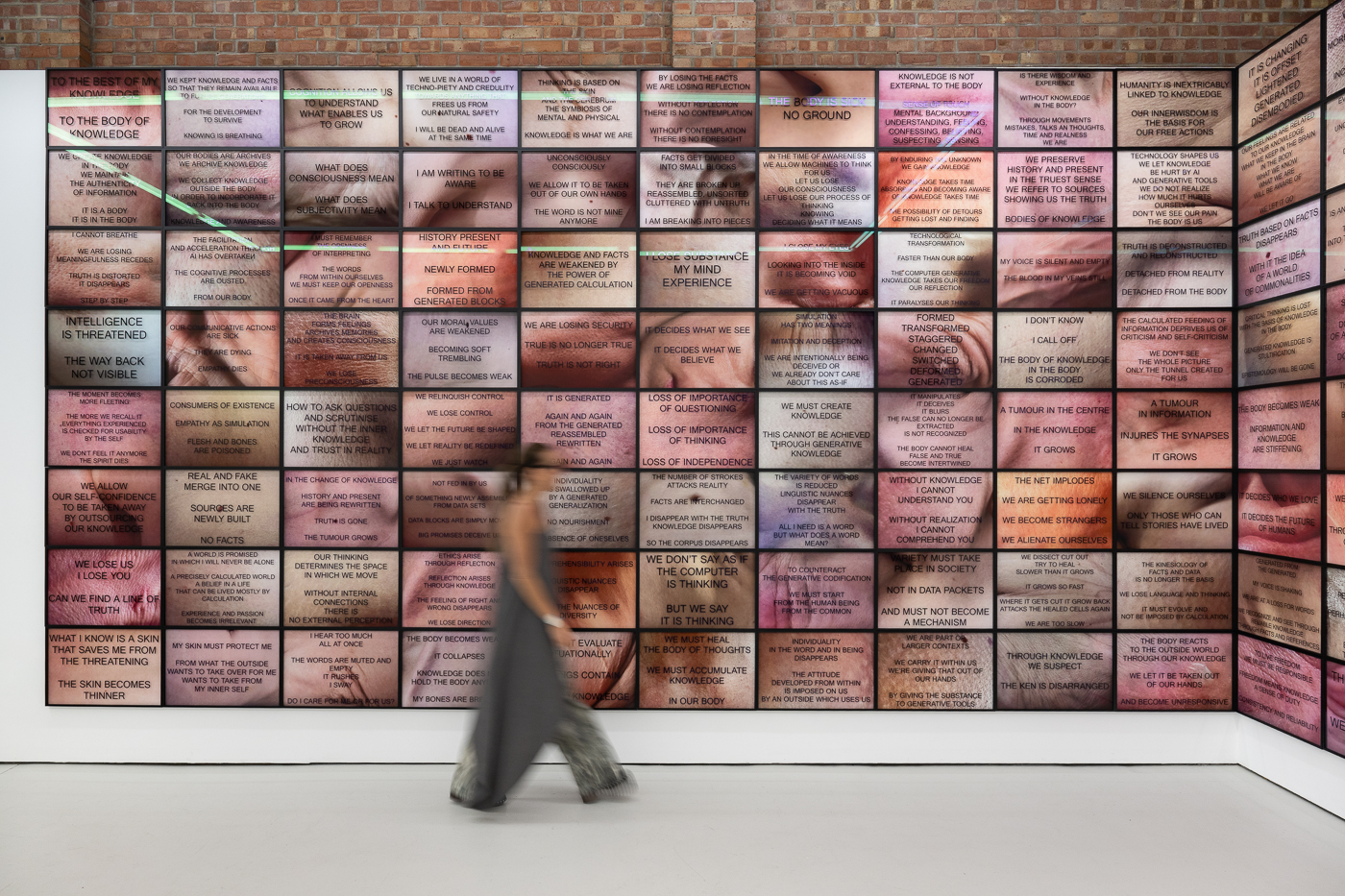Mousse Magazine features a review of the group exhibition Quid est veritas? curated by Anton Svyatsky at ANNKA KULTYS GALLERY.
“Quid est veritas?” at Annka Kultys Gallery, London
Annka Kultys Gallery is pleased to present Quid est veritas?, a multi-generational group exhibition exploring the concept of philosophical truth. Through works by AES+F, Morehshin Allahyari, Imre Bak, crocodilePOWER, Simon Denny, Eva and Franco Mattes, Joseph Kosuth, Olia Lialina, Signe Pierce, Timur Si-Qin and Theo Triantafyllidis, curator Anton Svyatsky scrutinizes the cognitive mechanisms by which humans operate the label of truth.
“‘What is truth?’ said jesting Pilate, but would not stay for an answer.” – Francis Bacon (1561-1626)
The concept of truth has been and remains a central subject of philosophy, and yet its definition has proved elusive for thousands of years. In a time of universal deceit, propaganda, political truth-bending and outright condemnation of truth, it becomes imperative to examine our relationship with it. What is truth and what is its role? Why do we pursue knowledge of it and claim to espouse it?
“To say of what is, that it is, or of what is not, that it is not, is true.” – Aristotle (384-322 BC)
Contemporary language operates in modes of enquiry and assertion, under the assumption that each statement is true. This makes it frighteningly simple to take advantage of the gullible. Enter doubt, the defence-mechanism against malicious misinformation. Tellingly, children do not know how to doubt until confronted with the violent destruction of trust caused by a demonstrable falsehood. Until that moment, a child presumes everything she is told to be true. Certainly it is difficult to imagine how a child could survive if it were otherwise.
“In order to seek truth, it is necessary once in the course of our life, to doubt, as far as possible, all things.” – Rene Descartes (1596-1650)
Unlike the subjective moral properties (good, bad, etc.), we like to believe that truth is objective, and that it corresponds with the actual state of affairs in the world. Before the information age, the only source of truth was authority, whether spiritual, scholastic or governing – one and the same for most of human history. Even publicly accessible libraries and archives are mediated by cultural self-selection and oftentimes authority of the state, especially under a totalitarian regime. With the dawning of the information age came unprecedented access to knowledge, and with that access, doubt has engulfed humanity. It can be said that doubt is the herald of enquiry and thus the harbinger of truth. Without doubt, no progress towards truth can be made. So let us doubt for just a moment the notion of truth itself. To believe something is ipso facto believing it to be true. Each work in Quid est veritas? is intended as a provocation to self-examination. The spectator is invited to doubt their belief system by inquiring into their own process of belief formation.
“Truth that has been merely learned is like an artificial limb, a false tooth, a waxen nose; at best, like a nose made out of another’s flesh; it adheres to us only because it is put on.” – Arthur Schopenhauer (1788-1860)
The work of Russian art collective AES+F, part of their Islamic Project series, represents a vision of the West’s future through the prism of colonisation by Islamic culture. The work can be read as a form of psychoanalysis, presenting an apparent untruth that corresponds to or strengthens an existing belief, thereby stimulating the sense of cognitive dissonance. By contrast, the conceptual work of Hungarian artist Imre Bak is a study of meaning – the deconstruction of an image demonstrates the fragility of meaning within representation. In a similar vein, the work of London-based American artist Joseph Kosuth is an examination and deconstruction of the production and representation of meaning in language.
Greek artist Theo Triantafyllidis’s 3-channel piece Seamless simulates an environment inhabited by animals and machines which exhibit no discernible difference in behaviour, suggesting a post-human world where technology, no longer encumbered by its human creators, negotiates a place for itself within greater nature. New Peace, a VR installation by the New York based German-Chinese artist Timur Si-Qin, is a meditation on New Age propaganda, a ritual of indoctrination into a faith that is both secular and mystical. Addressing connate themes, Berlin-based New Zealand artist Simon Denny’s work juxtaposes the language of tech-advertising with the evangelism of spiritual and wellness propaganda. Across the gallery from Si-Qin’s New Peace, another VR work by New York based Iranian artist Morehshin Allahyari, places the viewer in a dark spiritual world at the altar of an arcane god, guiding her through a primordial experience akin to an ancient rite.
Provoking reflection on the global social networks that most of humanity currently inhabits, both reality artist Signe Pierce, and Russian art duo crocodilePOWER, exploit contemporary media structures with their contributions to reveal our simulated sense of perpetual interconnectedness. In another perspective, the work of Berlin-based Olia Lialina of the “Online Newspaper Series,” is a humorous and subversive visual commentary on the never-ending news cycle that feeds us information, constantly engaging our internal cognitive process of truth-making. Similarly, New York based Italian duo, Eva and Franco Mattes, explore the mythology of the internet, informational logistics and belief formation in the mass-consciousness of humanity.
“What then is truth? A movable host of metaphors, metonymies, and anthropomorphisms: in short, a sum of human relations which have been poetically and rhetorically intensified, transferred, and embellished, and which, after long usage, seem to a people to be fixed, canonical, and binding.” – Friedrich Nietzsche (1844-1900)
Quid est veritas? is organised by New York based Russian-American curator, Anton Svyatsky.


